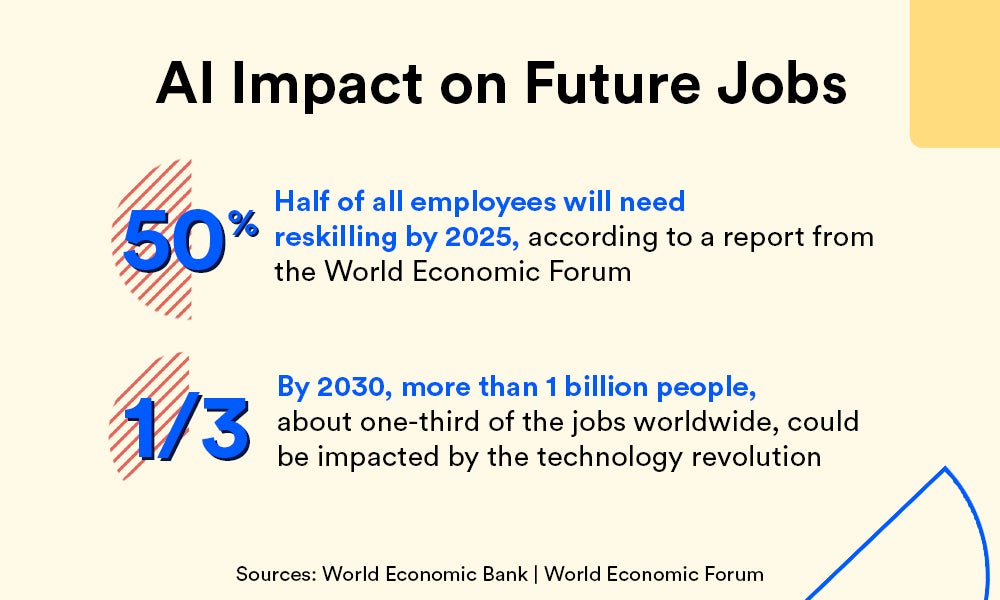Investing in artificial intelligence (AI): A beginner’s guide

The rapid pace of innovation in artificial intelligence (AI) has brought many experiences to reality that were previously only thought to be fiction. As AI continues to disrupt how we live and work, how can investors put money to work in this advanced technology that is quickly reshaping society?
We’ve created this handy beginner’s guide to help you better understand what AI is and how companies use the technology. Plus, we’ve identified some popular investments in this fast-growing industry.
What is AI?
AI attempts to replicate human intelligence in a computer or machine with faster speed and greater accuracy. Companies like Microsoft (MSFT) and Google (GOOGL) employ the technology to program machines to solve problems, answer questions and conduct tasks previously done by humans.
As systems become more intelligent, AI becomes more powerful, and its uses and applications reach every stock sector and industry. For example, the transportation industry is undergoing a massive transformation around electric and autonomous vehicles, potentially bringing trillions of dollars to the global economy. Similarly, the banking industry uses AI to improve decision-making in high-speed trading, automate back-office processes like risk management, or even reduce costs by using humanoid robots in branches. And those are only a few examples of artificial intelligence applications.

Analysts at International Data Corp. (IDC), a provider of market intelligence, predict that worldwide revenues for the AI market could reach $900 billion by 2026, logging a compound annual growth rate of 18.6 percent from 2022-2026.
“ChatGPT’s explosive global popularity has given us AI’s first true inflection point in public adoption,” says Ritu Jyoti, group vice president, Worldwide Artificial Intelligence and Automation Market Research and Advisory Services at IDC. “As AI and automation investments grow, focus on outcomes, governance, and risk management is paramount.”
How companies use AI
Whether it’s law-enforcement agencies using facial recognition software to conduct investigations, AI-powered home appliances like Samsung’s smart refrigerators making our lives easier, or robo-advisors using automated, algorithm-driven models to optimize our investments and make financial-planning recommendations, AI is everywhere.
At AI’s core is big data, which data scientists, engineers, and other experts use to build complex algorithms that can take in new information to improve their performance and accuracy. With machine learning, for example, a sub-field of AI, organizations like Netflix employ user data to make content recommendations and predictions. As users input more information, such as giving a show a thumbs up or thumbs down, the system then stores and processes that knowledge — incrementally becoming smarter.

According to a survey of more than 350 AI researchers conducted by the University of Oxford and Yale University in 2015, there is a 50 percent chance that machines could outperform humans in all tasks by the year 2060. And some tech visionaries like Tesla CEO Elon Musk believe it could be much sooner.
Organizations increasingly tap into the power of AI to inform critical business decisions, such as prioritizing medical care in an emergency, enhancing recruitment practices, and determining an individual’s eligibility for credit, housing and other essential services.
There’s also a lot of debate on how AI will impact the job market. As humans’ dependence on machines increases, so does the need for employees to improve and learn new skills. By 2030, the World Economic Forum estimates that more than 1 billion people, about one-third of the jobs worldwide, could be impacted by the technology revolution.
To account for the limitations of AI — at least until the technology further evolves — organizational leaders have relied on augmented intelligence, which combines machine intelligence and human expertise. In essence, augmented intelligence empowers humans to work better and faster. The need for humans’ input, however, diminishes as AI gets stronger.
How to invest in artificial intelligence
For most retail investors, there’s a chance you already have exposure to AI, as many large U.S. public companies are either using AI or are actively looking to invest in the technology.
But for those looking for broader exposure, exchange-traded funds (ETFs) offer an efficient and easy way to invest in AI stocks.
Similar to other thematic investing types — such as blockchain technology, cybersecurity and genomics — AI ETFs hold a basket of publicly traded companies involved in various phases of AI, from development to implementation.
Outlined here are some of the most widely owned AI ETFs. As you consider these options, make sure to review the fund’s prospectus to understand the investment strategy, holdings and fees.
Note: All ETF data below is as of January 16, 2024.
Global X Robotics & Artificial Intelligence ETF (BOTZ)
BOTZ invests in companies focused on AI and robotics technologies across sectors in developed world markets.
Fund issuer: Mirae Asset Global Investments
Assets under management: $2.3 billion
Top holdings: NVIDIA (NVDA), ABB Ltd (ABBN) and Intuitive Surgical (ISRG)
Expense ratio: 0.69 percent
ARK Autonomous Technology & Robotics ETF (ARKQ)
ARKQ identifies and invests in domestic and foreign companies that could benefit from emerging technologies and automation.
Fund issuer: ARK Invest
Assets under management: $973.1 million
Top holdings: Tesla (TSLA), Iridium Communications (IRDM), UiPath (PATH) and Kratos Defense & Security Solutions (KTOS)
Expense ratio: 0.75 percent
ROBO Global Robotics and Automation Index ETF (ROBO)
ROBO invests in a global index of companies driving innovation through robotics, automation and AI.
Fund issuer: Exchange Traded Concepts
Assets under management: $1.3 billion
Top holdings: Azenta (AZTA), Intuitive Surgical Inc (ISRG), Illumina (ILMN) and iRhythm Technologies (IRTC)
Expense ratio: 0.95 percent
Editorial Disclaimer: All investors are advised to conduct their own independent research into investment strategies before making an investment decision. In addition, investors are advised that past investment product performance is no guarantee of future price appreciation.






